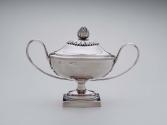Advanced Search
Covered bowl or spice container (especiero)
Probably by: Gumersindo de Canas (Mexican, born in 1783)
Assayer: Jose Joaquin Davila (working 1819–1823)
Assayer: Jose Joaquin Davila (working 1819–1823)
1819–1823
Object Place: Mexico City, Mexico
Medium/Technique
Silver
Dimensions
14.3 x 20.6 x 9 cm (5 5/8 x 8 1/8 x 3 9/16 in.)
Credit Line
Gift of Kathryn C. Buhler in memory of Yves Henry Buhler
Accession Number1984.184a-b
NOT ON VIEW
CollectionsAmericas
ClassificationsSilver hollowware
The identification and dating of Latin American silver is challenging due to the paucity of maker’s marks. Fortunately, an assayer mark is often present. Assayers were bureaucrats, and the years of their appointment are a matter of public record. As a result, their marks can often provide a date range for an object when little other evidence is available.
In the case of this covered bowl, the assayer’s mark is that of José Joaquín Dávila, who held his post between 1819 and 1823. The maker could be either Alejandro Antonio de Cañas (b. 1755) or Gumersindo de Cañas, for both men used the shaped touchmark that bears their surname. Alejandro Cañas would have been sixty-four years old by 1819, whereas Gumersindo Cañas would have been only thirty-six. In addition, in the years 1823 – 24, the latter’s mark appears more frequently with the assayer’s mark of Cayetano Buitrón (w. 1823 – 1824). It is therefore likely this vessel was made by the younger silversmith.
The elliptical form of the bowl, its square foot, and its graceful cane-shaped handles demonstrate the far-reaching influence of the French Neoclassical style as disseminated by Robert Adam, the English designer. Adam’s work exerted a powerful influence on the Academy of San Carlos in Mexico. The shape of the bowl is based upon a conflation of the kylix and kantharos, ancient Greek drinking vessels. In the evolution of this new classical style, ellipses were preferred over circles, and a greater variety of shapes, including lids, were created to serve myriad purposes. A circular covered bowl with similar handles, made by Paul Revere and now in the Museum’s collection, demonstrates how the Neoclassical style found favor throughout the Western world and its colonies during the early years of the nineteenth century.
Forms such as this bowl made in Latin America are also called especieros, or spice containers. Smaller examples are sometimes called saleros, or salt cellars.4 Notable for its finely planished surface and handsome cast and cold-worked finial, this covered container would have served as a fine addition to an upper-middle-class home in the viceroyalty of New Spain.
This text has been adapted from "Silver of the Americas, 1600-2000," edited by Jeannine Falino and Gerald W.R. Ward, published in 2008 by the MFA. Complete references can be found in that publication.
In the case of this covered bowl, the assayer’s mark is that of José Joaquín Dávila, who held his post between 1819 and 1823. The maker could be either Alejandro Antonio de Cañas (b. 1755) or Gumersindo de Cañas, for both men used the shaped touchmark that bears their surname. Alejandro Cañas would have been sixty-four years old by 1819, whereas Gumersindo Cañas would have been only thirty-six. In addition, in the years 1823 – 24, the latter’s mark appears more frequently with the assayer’s mark of Cayetano Buitrón (w. 1823 – 1824). It is therefore likely this vessel was made by the younger silversmith.
The elliptical form of the bowl, its square foot, and its graceful cane-shaped handles demonstrate the far-reaching influence of the French Neoclassical style as disseminated by Robert Adam, the English designer. Adam’s work exerted a powerful influence on the Academy of San Carlos in Mexico. The shape of the bowl is based upon a conflation of the kylix and kantharos, ancient Greek drinking vessels. In the evolution of this new classical style, ellipses were preferred over circles, and a greater variety of shapes, including lids, were created to serve myriad purposes. A circular covered bowl with similar handles, made by Paul Revere and now in the Museum’s collection, demonstrates how the Neoclassical style found favor throughout the Western world and its colonies during the early years of the nineteenth century.
Forms such as this bowl made in Latin America are also called especieros, or spice containers. Smaller examples are sometimes called saleros, or salt cellars.4 Notable for its finely planished surface and handsome cast and cold-worked finial, this covered container would have served as a fine addition to an upper-middle-class home in the viceroyalty of New Spain.
This text has been adapted from "Silver of the Americas, 1600-2000," edited by Jeannine Falino and Gerald W.R. Ward, published in 2008 by the MFA. Complete references can be found in that publication.
DescriptionThe raised, broad, elliptical vessel is supported by a short stem spreading to a splayed and stepped base and square plinth. Two long strap handles are attached below, near the stem and at the lid, and a leaf is chased at the upper join. The handles rise upward to the base of the finial. A conforming friction-fitted lid has one shallow step and rises to a height nearly equal to the depth of the bowl. A large bud finial with spreading foliage has been cast and cold-chiseled.
Marks
“CAN,” a portion of the maker’s mark CAÑAS; “M” crowned within a shaped cartouche; assayer’s mark “DVLA”; and a lion within a shaped oval, all struck from left to right on one side of vessel.
InscriptionsNone.
ProvenanceThe donor inherited the object from her husband, whose family used it for christenings during the nineteenth century.



